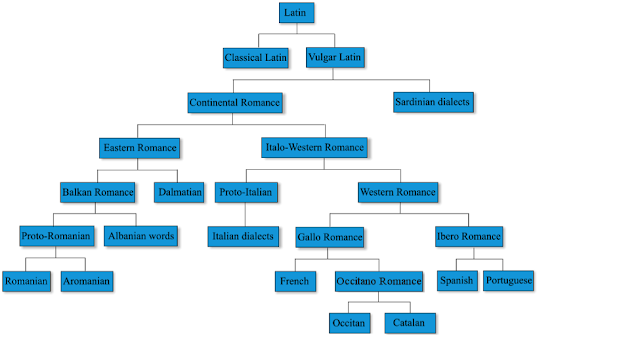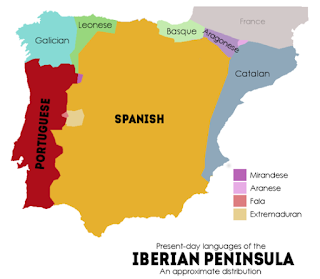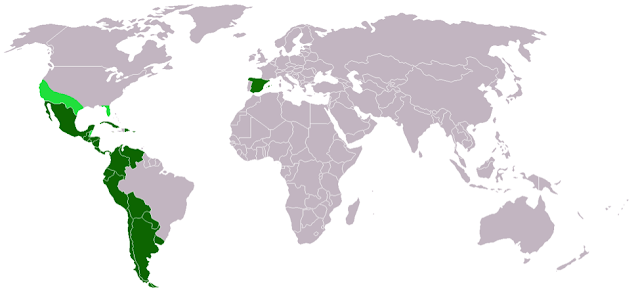By: Nidhi Shastri
"E aí, galera! Tudo bem?” These are the famous (Portuguese) words of Brazilian filmmaker, musician, and youtuber Joe Penna, also known as, MysteryGuitarMan. He typically says this phrase at the start of each video, and it roughly translates to: “What’s up guys! Is everything good?” in English, and “¿Qué tal? ¿Todo bien?” in Spanish. For many years I watched his videos and tried to figure out what exactly he was saying, and as a Spanish speaker, it took a few tries to parse out exactly what the similar phrasing would be in Spanish. As I explored the relationship between the language of one of my favorite stars, Joe Penna, and the language I speak and study, Spanish, I began to gain a deeper understanding about the linguistic, social, and political ties between the languages offered up by Penna in his peculiar mixtures of Spanish and Portuguese. What I discovered, is that the gap between the two is as much a social one as a technical one.
During my time as a Spanish speaker, I have always wondered about its sister language—Portuguese. Spain and Portugal are intertwined by economy, trade, and culture. The two countries share more than just a border; their languages have linguistic similarities and differences that are hard to ignore. It is not rare to hear people who speak Spanish claim to understand large parts of Portuguese, and vice-versa. I myself, as a Spanish speaker, have been meaning to begin to learn Portuguese, as I have heard their similarities time and time again. Let’s draw out a bit of the history and linguistic similarities of these languages.
Both languages, Spanish and Portuguese, are considered “Ibero Romance Languages.” In fact, they are the only two that fall under that distinct classification. Both languages also originated in the Iberian Peninsula, which is currently still shared by both Spain and Portugal. They are both decedents of Latin, and though they are similar to Catalan, Occitan, and even French, they are intertwined much more with each other. This is because Portugal historically is a bit cornered by Spain, and the rest of it is bordered by the North Atlantic Ocean. The two languages were able to converge in isolation to a certain extent, for long periods of time. The language’s evolutions to what we now know of them as can be traced as far back as 27 BCE, a time when there were many different languages emerging from Latin (Wong, 2015). Similar words can be easily traced out today, “constitución becomes constituição… Lengua is lingua, and idioma is idioma,” (Wong, 2015). Even as we saw in MysteryGuitarMan’s greeting, “todo” in Spanish is “tudu” in Portuguese and “bien” in Spanish is “bem” in Portuguese. Though emphasis and pronunciations differ, many words are still spelled and accented in the same way.
However, their differences are an important part of their history too. The most distinctive split came with the fall of the Roman Empire in 5th Century CE (Wong, 2015). This was a pivotal point in history, where Arabic colonizers (the Moors) would characterize the fabric of Portuguese, and Roman colonizers the fabric of Spanish. This small but distinct difference in influence led to a big difference in the two languages, and thus made it so that the languages are still pretty hard to cross-understand even by native speakers today. So, although both languages are technically similar and have their roots in the same land, they are distinct, and many people argue they are hardly the same thing.
As we so often see, society plays a large role in how people perceive similarities and differences between themselves and others. This is exhibited in Spain and Portugal as well. Language is a part of national identity for both places, and it is something both countries have spread around the world as a symbol of their colonialization of different lands. First, let’s explore a bit about these two countries’ political relation, and then expand that to their colonies. This can show us how the similarities and differences are social, I would argue, possibly more so than they are linguistic. Then, we will take a look at how this plays out in their colonial past.
As for the current day relationship between Portugal and Spain, between the period of 1580 to 1640, the two countries lived as “Siamese twins joined at the back,” (Chislett, 2014). Now, they operate closely together in the European Union. Since 30% of Portugal’s total imports come from Spain, their economies are deeply intertwined (Chislett, 2014). Both of these factors show that the two countries are politically and economically cohesive, even if they do have minor conflicts from time to time. However, seeing language as a piece of their identities socially separates the people of these two countries. Each sees their language as the rifting factor that holds them apart. It is good for national identity, however, it put strains on the connectivity that can be harnessed between these two countries and groups of people.
If we expand this to the colonies of Spain and Portugal, it is even more interesting. For starters, there is great linguistic differences between Spain and its colonies. For example, Latinx countries pronounce the letter “y” as the sound “j.” So, as a Spaniard would say “yo” straight, a Latinx person would say, “j-yo.” Furthermore, different words are significant, too. While “fresa” means strawberry in Spain, it can be used to refer to a rich, snobby person in countries like Mexico. This is just one linguistic and translation difference in the many different Latinx countries. As for places that have been colonized by Portugal, there is even more linguistic differentiation. For example, India has many people with Portuguese names, heritage, and language, which causes different variations of the language mixed with Indian ones. The most commonly known colony, Brazil, is its own linguistic beast. Surrounded by Latinx countries, it too differs in the influence it has had by the different types of Spanish surrounding it, as well as the evolution of the language itself in Brazil as opposed to the Portuguese spoken in Portugal.
These linguistic differences further a political and social separation. While distinction is important and powerful, there is still a big gap between the people of the Portuguese language and those who speak Spanish. However, the two languages are very similar, and it does beg the question: if these countries’ governments invested in the learning of each other’s languages, would a new, trilingual population arise? Would that provide more autonomy in the “lingua franca” scene across the globe? While there is great power in acknowledging differences, I do believe it would be cool to see linguistic similarities and differences give rise to a new generation of speakers, or even possibly a new hybrid language, that can bridge people from all around the world.
“Ya sabemos algunas cosas sobre el lenguaje de los políticos. Es un instrumento de dominio, que nace en el mismo momento en que nace la primera sociedad” (Mellizo 1990: 135). This quote translates to, “We already know a few things about the language of politicians. It is an instrument of dominion, that is born at the moment when the first society is born.” Language and politics are both crucial to the dynamics of countries such as Spain and Portugal. When looking at their shared linguistics, it is amazing to see the possible links that can occur within a new language of politics, one that emphasizes the rich similarities between Spanish and Portuguese. With that, the world can become more connected under this new generation of Lingua Franca speakers.
References
Wong, Kevin. “Iberia's Children: A Short History of Why Portuguese and Spanish Are
Different” Unravel Magazine.” Unravel, 2015, unravellingmag.com/articles/portuguese-and-spanish/.
De Cock, Barbara. Spain, Portugal and Europe in Spanish international relations discourse: a l
linguistic approach to group and identity construction/España, Portugal y Europa en el discurso español sobre relaciones internacionales: un enfoque lingüístico de la construcción de identidad y grupo. In: Michel Dumoulin, Antonio Ventura Díaz Díaz, Portugal y España en la Europa del siglo XX, Fundación Academia Europea de Yuste : Yuste 2005, p.279-300
Chislett, William. “Strategic and International Studies.” Real Instituto Elcano, Fundación Real
Instituto Elcano, 2004, www.realinstitutoelcano.org/wps/portal/rielcano_en/contenido?WCM_GLOBAL_CONTEXT=%2Felcano%2Felcano_in%2Fzonas_in%2Fdt46-2004.
Nidhi Shastri is a senior in Environmental and political Science at The University of Illinois. Nidhi’s future plans include graduating and working is Chicago regarding communications. Nidhi wrote this blog post in 418 'Language and Minorities in Europe' in spring 2019.
 |
| Figure 1: Joe Penma, also known as MysteryGuitarMan Source: YouTube |
During my time as a Spanish speaker, I have always wondered about its sister language—Portuguese. Spain and Portugal are intertwined by economy, trade, and culture. The two countries share more than just a border; their languages have linguistic similarities and differences that are hard to ignore. It is not rare to hear people who speak Spanish claim to understand large parts of Portuguese, and vice-versa. I myself, as a Spanish speaker, have been meaning to begin to learn Portuguese, as I have heard their similarities time and time again. Let’s draw out a bit of the history and linguistic similarities of these languages.
 |
| Figure 2: The family tree of Romance languages that descended from Latin Source: Wikimedia Commons |
 |
| Figure 3. Source: Wikimedia Commons |
However, their differences are an important part of their history too. The most distinctive split came with the fall of the Roman Empire in 5th Century CE (Wong, 2015). This was a pivotal point in history, where Arabic colonizers (the Moors) would characterize the fabric of Portuguese, and Roman colonizers the fabric of Spanish. This small but distinct difference in influence led to a big difference in the two languages, and thus made it so that the languages are still pretty hard to cross-understand even by native speakers today. So, although both languages are technically similar and have their roots in the same land, they are distinct, and many people argue they are hardly the same thing.
As we so often see, society plays a large role in how people perceive similarities and differences between themselves and others. This is exhibited in Spain and Portugal as well. Language is a part of national identity for both places, and it is something both countries have spread around the world as a symbol of their colonialization of different lands. First, let’s explore a bit about these two countries’ political relation, and then expand that to their colonies. This can show us how the similarities and differences are social, I would argue, possibly more so than they are linguistic. Then, we will take a look at how this plays out in their colonial past.
As for the current day relationship between Portugal and Spain, between the period of 1580 to 1640, the two countries lived as “Siamese twins joined at the back,” (Chislett, 2014). Now, they operate closely together in the European Union. Since 30% of Portugal’s total imports come from Spain, their economies are deeply intertwined (Chislett, 2014). Both of these factors show that the two countries are politically and economically cohesive, even if they do have minor conflicts from time to time. However, seeing language as a piece of their identities socially separates the people of these two countries. Each sees their language as the rifting factor that holds them apart. It is good for national identity, however, it put strains on the connectivity that can be harnessed between these two countries and groups of people.
 |
| Figure 4: Hispanic Countries Source: Wikimedia Commons |
 |
| Figure 5: Countries that speak Portuguese |
These linguistic differences further a political and social separation. While distinction is important and powerful, there is still a big gap between the people of the Portuguese language and those who speak Spanish. However, the two languages are very similar, and it does beg the question: if these countries’ governments invested in the learning of each other’s languages, would a new, trilingual population arise? Would that provide more autonomy in the “lingua franca” scene across the globe? While there is great power in acknowledging differences, I do believe it would be cool to see linguistic similarities and differences give rise to a new generation of speakers, or even possibly a new hybrid language, that can bridge people from all around the world.
“Ya sabemos algunas cosas sobre el lenguaje de los políticos. Es un instrumento de dominio, que nace en el mismo momento en que nace la primera sociedad” (Mellizo 1990: 135). This quote translates to, “We already know a few things about the language of politicians. It is an instrument of dominion, that is born at the moment when the first society is born.” Language and politics are both crucial to the dynamics of countries such as Spain and Portugal. When looking at their shared linguistics, it is amazing to see the possible links that can occur within a new language of politics, one that emphasizes the rich similarities between Spanish and Portuguese. With that, the world can become more connected under this new generation of Lingua Franca speakers.
References
Wong, Kevin. “Iberia's Children: A Short History of Why Portuguese and Spanish Are
Different” Unravel Magazine.” Unravel, 2015, unravellingmag.com/articles/portuguese-and-spanish/.
De Cock, Barbara. Spain, Portugal and Europe in Spanish international relations discourse: a l
linguistic approach to group and identity construction/España, Portugal y Europa en el discurso español sobre relaciones internacionales: un enfoque lingüístico de la construcción de identidad y grupo. In: Michel Dumoulin, Antonio Ventura Díaz Díaz, Portugal y España en la Europa del siglo XX, Fundación Academia Europea de Yuste : Yuste 2005, p.279-300
Chislett, William. “Strategic and International Studies.” Real Instituto Elcano, Fundación Real
Instituto Elcano, 2004, www.realinstitutoelcano.org/wps/portal/rielcano_en/contenido?WCM_GLOBAL_CONTEXT=%2Felcano%2Felcano_in%2Fzonas_in%2Fdt46-2004.
I felt like this was the most relatable article I came across as it discussed things that I am interested in. This article specifically sparked ideas for what I could possibly write about in my own blog. My major is also Spanish and I have attempted to study Portuguese and Italian. I agree with the point that was towards the end, I think it would be cool to have Portuguese and Spanish be taught more.
ReplyDelete